written and photographed by Mary L. Peachin
Jul 2000, Vol. 4 No. 10
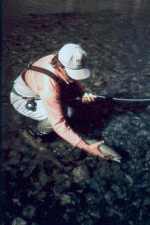 Rivers meander through quiet wilderness, where eagles soar, and ducks paddle the edge of the banks. Deer, elk, maybe the occasional bear can be sighted. Sometimes rivers wind through canyons that would otherwise be inaccessible. And for the angler, flyfishing water is always gentle, drift boats seldom have rapids to run. Miles can be floated while relaxing in a drift boat, without the worry of a fly line hooked into a tree branch.
Rivers meander through quiet wilderness, where eagles soar, and ducks paddle the edge of the banks. Deer, elk, maybe the occasional bear can be sighted. Sometimes rivers wind through canyons that would otherwise be inaccessible. And for the angler, flyfishing water is always gentle, drift boats seldom have rapids to run. Miles can be floated while relaxing in a drift boat, without the worry of a fly line hooked into a tree branch.
Walking a river adds the challenge of navigating over slippery, algae-covered rocks, but the felt covering on the soles of wading boots worn over Gore-Tex or neoprene waders provides stability.
Whether you float or walk, the scenery is idyllic. All you need is a fly rod, the waders, and most importantly, a long-billed cap. If you look the part and enjoy the outdoors, some might say that catching and release a fish is immaterial. At least, that is the message I convey to the uninitiated, those who are about to become challenged by the sport. The family and friends I have mentored into flyfishing, are the same ones who will sooner or later wrapped a flyline and hook into my cap.
 My own experience has helped me to be selective in the choice of rivers to wade or float with beginners. I didn’t have such an easy initiation.
My own experience has helped me to be selective in the choice of rivers to wade or float with beginners. I didn’t have such an easy initiation.
During the 80’s, I booked a tarpon-fishing trip to Florida. I “lust” for these hundred pound, strong, frenzied saltwater jumpers, known as “silver-kings.” My fishing guide, Gene Montgomery, called to tell me that giant tarpon, weighing almost 200 pounds, were running in schools near the flats of the Hommossa River on the west coast of Florida. He added, “Mary, bring a 9-weight or heavier fly rod. The fish are only hitting on flies.” Gulp! I had never been flyfishing.
 I had only a month to learn the technique, and develop the strength to cast a very heavy fly rod. I called a flyfishing store in my hometown of Tucson, for some reason named “The Outhouse,” to share my predicament, and I pleaded with the owner to teach me how to use a fly rod.
I had only a month to learn the technique, and develop the strength to cast a very heavy fly rod. I called a flyfishing store in my hometown of Tucson, for some reason named “The Outhouse,” to share my predicament, and I pleaded with the owner to teach me how to use a fly rod.
Our casting lessons began in the alley behind his store. After a week, I graduated to the pond at Fort Lowell Park. Casting, without a hook, near the “Absolutely No Fishing” sign, bypassers stared at my alleged inability to read the sign. I persevered. At the same time, I spent a lot of time lifting free weights in the gym to increase my upper-body strength.
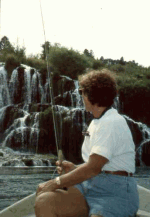 Four weeks later I arrived in Florida, a rookie fishing with world class fly anglers. Gene quietly poled the skiff through the flats so we wouldn’t scare the skittish tarpon. Casting, hooking, fighting, and releasing each of these fish were usually a two-hour ordeal for me. Aching arms made it difficult to lift a telephone.
Four weeks later I arrived in Florida, a rookie fishing with world class fly anglers. Gene quietly poled the skiff through the flats so we wouldn’t scare the skittish tarpon. Casting, hooking, fighting, and releasing each of these fish were usually a two-hour ordeal for me. Aching arms made it difficult to lift a telephone.
My initiation might have been exciting and challenging, but it was not the best introduction to flyfishing. My recommendation is to find a river of your choice, or a destination you have always wanted to visit, and hire the very best guide. My role as a mentor includes the introduction and lots of encouragement.
A good guide will know every bend and curve of the river. Trout are sedentary, and the guide will know the pools and riffles filled with trout, and the insect they are eating. I tend to select guides under the age of thirty. There is less chance of arrogance and machismo. My conclusion after all these years is to pay for the expertise of a guide. It’s worth it.
The key to flyfishing is knowing the type of insect larvae or the species of the “hatch” flying off the river. After learning the technique of casting that sleek s-curved line, the idea is to fool the trout with a gentle “presentation,” one that simulates the insect preference of the fish.
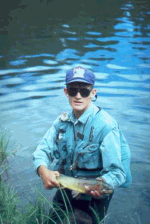 A rite of Peachin family passage included the learning of flyfishing. Another recreational priority was scuba diving certification. These two skills make for some wonderful family vacations.
A rite of Peachin family passage included the learning of flyfishing. Another recreational priority was scuba diving certification. These two skills make for some wonderful family vacations.
It was serendipitous that my son, Jeffrey, was thinking about a career change when I introduced him to flyfishing on Slough Creek, a premier trout stream in Yellowstone National Park. Three weeks later, I kid you not, he was enrolled in a graduate program at Montana State University in the nearby city of Bozeman. And squeezed into his spring schedule, between lots of accounting courses, was an elective—flyfishing.
Those college years in Bozeman paved the way for family vacations with lots of fishing on the Yellowstone, Gallatin, Madison, Missouri, and Big Hole rivers. My daughter, Suzie, having learned to fish in the surf of Mission Beach, California at the age of three, took flyfishing in stride. She adapted well and easily to the river. And where the kids go, the dad follows. Husband David was an easy convert, especially after a couple of float trips where he released the biggest trout.
Happy with the success of introducing and sharing the experience of flyfishing with my husband and children, I enrolled in a three-day course offered by Montana State University. I picked up a fishing buddy during a conversation about my future travel plans.
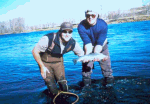 Best known as a Tucson’s fund-raising maven, Joan Beigal Kaye’s outdoor experience, at the time, didn’t include much more than speed-walking on shopping trips between Madison and Fifth Avenue in Manhattan..
Best known as a Tucson’s fund-raising maven, Joan Beigal Kaye’s outdoor experience, at the time, didn’t include much more than speed-walking on shopping trips between Madison and Fifth Avenue in Manhattan..
Joan took on more than just the challenge of learning to cast a fly rod. She learned to wade in strong currents while wearing cumbersome waders and boots. She hiked muddy trails, and became a pro at managing without toilet facilities. Our last day was spent in Yellowstone National Park, where “the big city” angler fished the Lamar River, with one eye glued on a bison grazing across the riverbank. Enroute to a seven-day, 125-mile (grueling) horseback trip through the Wind River Range of the Bridger Wilderness, Wyoming, part-time Tucsonan Gail Goode and I took a day to float the South Fork of the Snake River in Idaho. It wasn’t exactly on the route, but the day was beautiful and the scenery of the western side of the Tetons was spectacular. Gail was able to experience the thrill of catching native cutthroat trout on a “dry” fly. A dry fly floats on the surface of the river allowing you to watch the trout jump for the fly.
 After returning from some stunning scenery and a private river owned by the estancia Arroyo Verde, in Patagonia, Argentina, Bud Henderson, a Tucson flight instructor, and I fished closer to home (Tucson). Flying a four-seat Cessna 182, we landed on the dirt strip in Marble Canyon, Arizona to fish Lee’s Ferry. One of the state’s finest fishery is located on the Colorado River below the Glen Canyon Dam. Hungry, spawning rainbows took our flies as I enjoyed watch Bud consumed by a new challenge. Bariloche, Patagonia might be considered a world class fishery, but so is Lee’s Ferry and it is, relatively speaking, right in my own backyard.
After returning from some stunning scenery and a private river owned by the estancia Arroyo Verde, in Patagonia, Argentina, Bud Henderson, a Tucson flight instructor, and I fished closer to home (Tucson). Flying a four-seat Cessna 182, we landed on the dirt strip in Marble Canyon, Arizona to fish Lee’s Ferry. One of the state’s finest fishery is located on the Colorado River below the Glen Canyon Dam. Hungry, spawning rainbows took our flies as I enjoyed watch Bud consumed by a new challenge. Bariloche, Patagonia might be considered a world class fishery, but so is Lee’s Ferry and it is, relatively speaking, right in my own backyard.
During a summer visit to Steamboat Springs, my husband David and I were fortunate to stay with some friends, Ken and Judy Riskind, who just happen to have a neighbor, Steve Palmer, with a blue ribbon trout stream running through his ranch. Another day, the four of us did a float fish trip down the Yampa river.
Last fall, at a conference outing, I was paired up with David Bear from Pittsburgh. This was David’s first wilderness experience, and while he only wrapped his flyline around me twice during two days of fishing on the Bow River near Calgary, Alberta, he managed to catch the biggest fish of all.
Flyfishing is not about releasing the most or biggest fish. It is about sharing a wonderful outdoor experience, and enjoying a new challenge. And should you want a “mentor,” just send me an e-mail.
SIDEBAR: THE TECHNIQUE OF FLY FISHING
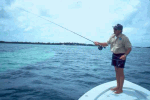 The skill of flyfishing is presenting the fish with an artificial bug or insect. The simulation must be precise and delicate so the trout doesn’t realize that the fly is manmade. Trout are savvy and know better when the fly is slapped on the water, the fishing line is dragged, or you announce your arrival by casting your shadow on the fish.
The skill of flyfishing is presenting the fish with an artificial bug or insect. The simulation must be precise and delicate so the trout doesn’t realize that the fly is manmade. Trout are savvy and know better when the fly is slapped on the water, the fishing line is dragged, or you announce your arrival by casting your shadow on the fish.
When trout are feeding on the bottom of the river, the technique used is called “nymphing.” The fly is weighted with lead so it will drift by the fish. A colorful piece of yarn or foam is used as a “strike indicator,” the slightest dip of the line in the water can be a bite. When fishing are rising to the surface to feed, the frenzy of the angler increases as they are able to visually watch the strike.
Fish vary in their feeding habits, and a good guide will dig in the mud along the riverbank to identify the larvae that is about to hatch. Some river’s have noticeable “hatches.” An angler can observe the hatching insects, identify them as they emerge from the river, then use the same fly.
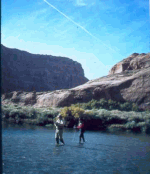 In Arizona, float tubes and pontoon boats are popular for lake fishing because they allow the angler, who sits in the tube wearing waders and fins, to paddle around the lake and avoid getting tangled in shore brush. The angler has a better opportunity to reach fish and can cast to the shoreline bank where lake fish frequently feed.
In Arizona, float tubes and pontoon boats are popular for lake fishing because they allow the angler, who sits in the tube wearing waders and fins, to paddle around the lake and avoid getting tangled in shore brush. The angler has a better opportunity to reach fish and can cast to the shoreline bank where lake fish frequently feed.
While flyfishing originated with fresh water trout fishing, it is now a popular salt-water game-fish sport. Sailfish and marlin fishing are “teased” to the boat by trolling a colorful artificial lure. When the sailfish or marlin rises on the teaser and is within casting distance, the teaser is pulled out of the water, as the angler casts the fly. Flyfishing Classes Women’s Adventure Class, Arizona Fish and Game (602) 981-9400 Lee’s Ferry Anglers (800) 962-9755 South Fork Lodge, Idaho (800) 483-2110 Chad Olson, Greater Yellowstone Flyfishers (406) 838-2468 Tucson’s Tight Lines Flyfishing shop (520) 322-9444
